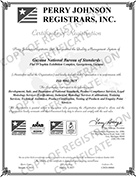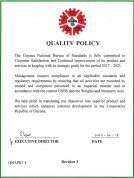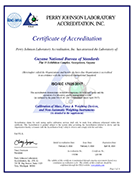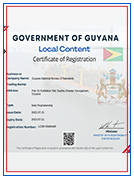During the month of April, labour organisations across the globe went into an awareness and advocacy mode to encourage organisations to improve and implement Occupational Safety and Health (OSH) practices in places of work. This culminated with observances on World Day of Safety and Health at Work on April 28, which provided opportunities to reflect on how to prevent work-related occupational diseases, deaths, injuries, and illnesses. It was also a day to remember those that have died from a work-related injury or illness.
Locally, many organisations and businesses, including the Guyana National Bureau of Standards (GNBS) are working to establish and maintain good Occupational Safety and Health practices in accordance with the OSH Act of 2004.
Meanwhile, with the implementation of the ISO 45001:2018 Occupational health and safety management systems – Requirements with guidance for use, organisations can go beyond the stipulations of the legislation to become leaders in OSH. This international standard has already been implemented by numerous corporations globally as a necessity or as an option to further improve practices.
The ISO 45001 specifies OSH management system requirements with guidance for use to enable organisations to provide safe and healthy workplaces by preventing work-related injury and ill health, as well as by proactively improving OSH performance.
The standard is applicable to any organisation that wishes to eliminate hazards and minimise risks (including system deficiencies), take advantage of OSH opportunities, and address management system non-conformities associated with its activities.
The implemented OSH system will ensure continual improvement of performance, help organisations fulfil legal and other requirements, and achieve their OSH objectives.
Crucial aspects covered by the standard include leadership and worker participation, which focus on leadership and commitment, organisational roles, responsibilities and authorities, and consultation and participation of workers. Organisations can also effectively plan to address their risks, opportunities, responses to emergencies.
To effectively implement the OSH management system, key supports must be put in place. As stated in the standard, these supports include the need for resources, the establishment of workers competence, worker awareness, and communication of the system.
Regarding the operation of the organisation, requirements outlined in the standard relate to operational planning and control, which covers eliminating hazards and reducing OSH risks, the management of change, procurement and outsourcing. In addition, conforming organisations must establish, implement and maintain a process(es) needed to prepare for and respond to potential emergency situations.
Finally as it relating to the standard, there is need for performance evaluation. Organisations have to a put a system in place to monitor, measure and analyse performance, and conduct internal audits and management reviews at planned intervals to ensure conformance of their OSH management system.
Though the requirements of this international standard would seem like a “big ask” to implement, implementation augers significant benefits to organisations. It provides a competitive advantage for those looking to serve the Oil and Gas Sector and it ensures a proactive approach to maintaining safety, thereby reducing liabilities.
The GNBS encourages local organisations to consider the implementation of this international standard to meet and exceed their OSH expectations.
For further information, or to purchase the standard, please contact the GNBS on telephone numbers: 219-0064/65/66. You can also visit the GNBS Facebook and Instagram pages for regular updates.






